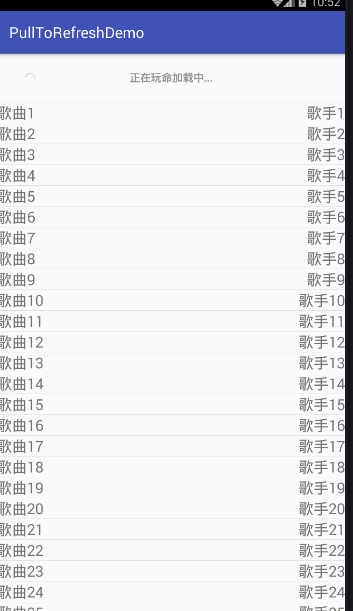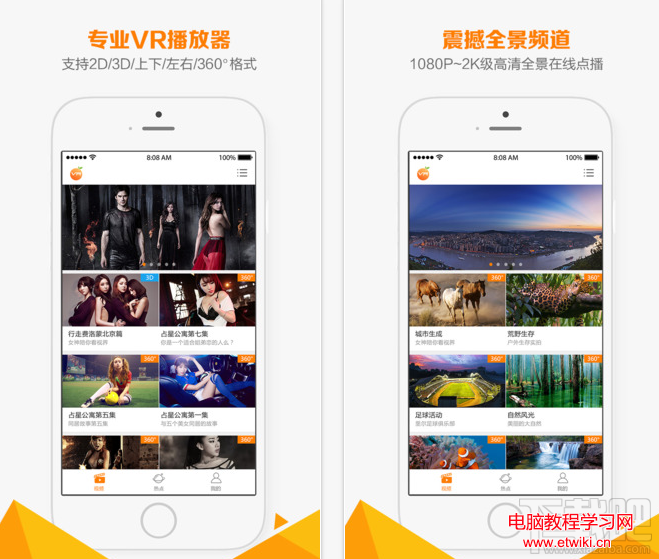編輯:關於Android編程
TextView中的超鏈接可以通過幾種方式實現:
一、Html.fromHtml方式
TextView,本身就支持部分的Html格式標簽。這其中包括常用的字體大小顏色設置,文本鏈接等。使用起來也比較方便,只需要使用Html類轉換一下即可: textView.setText(Html.fromHtml(str));
代碼如下:
public class Test10Activity extends Activity {
TextView textView ;
@Override
protected void onCreate(Bundle savedInstanceState) {
super.onCreate(savedInstanceState);
setContentView(R.layout.activity_test10);
textView = (TextView) findViewById(R.id.text);
String webLinkText = "<a href='https://souly.cn'> html超鏈接測試</a>" ;
textView.setText(Html.fromHtml(webLinkText));
}
}
這時候點擊超鏈接並沒有跳轉效果,需要加上
textView.setMovementMethod(LinkMovementMethod.getInstance());
之後才會跳轉。 這樣點擊之後會用默認浏覽器打開url。
現在字體顏色和下劃線是默認樣式,修改字體顏色比較簡單,可以直接用標簽:
String webLinkText = "<font color='#333333'><a href='https://souly.cn' style='text-decoration:none; color:#0000FF'> html超鏈接測試</a>" ;
但是想不借助其他類去掉下劃線就沒有辦法了。
還有一種更簡單的方法就是在TextView的xml布局中加入autoLink自動識別,這樣做操作最簡單,但是也不能修改樣式:
<TextView android:id="@+id/text" android:layout_width="wrap_content" android:layout_height="wrap_content" android:textSize="20sp" android:text="souly.cn" android:autoLink="email|phone|web" />
二、Spannable方式
在xml中設置了android:autoLink="email|phone|web"後,url文字下面會有一條下劃線,我們可以看URLSpan所繼承的類ClickableSpan 類的源碼,如下:
public abstract class ClickableSpan extends CharacterStyle implements UpdateAppearance {
/
* Performs the click action associated with this span.
*/
public abstract void onClick(View widget);
/
* Makes the text underlined and in the link color.
*/
@Override
public void updateDrawState(TextPaint ds) {
ds.setColor(ds.linkColor);
ds.setUnderlineText(true);
}
}
它調用ds.setUnderlineText(true); 設置了下劃線。我們再設置一個沒有下劃線的Spannable對象就可以了。 我們重寫一個類繼承UnderlineSpan,和ClickableSpan一樣,都是CharacterStyle的子類。
使用方法如下:
public class Test10Activity extends Activity {
TextView textView ;
@Override
protected void onCreate(Bundle savedInstanceState) {
super.onCreate(savedInstanceState);
setContentView(R.layout.activity_test10);
textView = (TextView) findViewById(R.id.text);
String webLinkText = "我的博客-->https://souly.cn" ;
textView.setText(webLinkText);
NoUnderlineSpan mNoUnderlineSpan = new NoUnderlineSpan();
if (textView.getText() instanceof Spannable) {
Spannable s = (Spannable) textView.getText();
s.setSpan(mNoUnderlineSpan, 0, s.length(), Spanned.SPAN_MARK_MARK);
}
}
public static class NoUnderlineSpan extends UnderlineSpan {
public NoUnderlineSpan() {}
public NoUnderlineSpan(Parcel src) {}
@Override
public void updateDrawState(TextPaint ds) {
super.updateDrawState(ds);
ds.setUnderlineText(false);
}
}
}
這樣textview在界面上就不會有下劃線了,但卻保留著autolink的功能。 這個超鏈接是默認顏色,如果需要改變顏色可以在xml中設置android:textColorLink="#1e84fb", 或者在java代碼中設置tv.setLinkTextColor(color);
上面的例子是在autoLink設置的情況下自動識別超鏈接的,如果不需要自動識別,而是自己手動設置需要跳轉的網址, 可以使用以下方法,首先刪除xml中的android:autoLink="email|phone|web"
public class Test10Activity extends Activity {
TextView textView ;
@Override
protected void onCreate(Bundle savedInstanceState) {
super.onCreate(savedInstanceState);
setContentView(R.layout.activity_test10);
textView = (TextView) findViewById(R.id.text);
String webLinkText = "我的博客" ;
SpannableString text = new SpannableString(webLinkText);
NoUnderlineSpan mNoUnderlineSpan = new NoUnderlineSpan("https://souly.cn") ;
text.setSpan(mNoUnderlineSpan,0,text.length(),Spanned.SPAN_EXCLUSIVE_EXCLUSIVE);
textView.setText(text);
textView.setMovementMethod(LinkMovementMethod.getInstance());
}
public static class NoUnderlineSpan extends URLSpan {
public NoUnderlineSpan(String url) {
super(url);
}
@Override
public void updateDrawState(TextPaint ds) {
super.updateDrawState(ds);
ds.setUnderlineText(false);
}
}
}
這裡的NoUnderlineSpan繼承了URLSpan而不是UnderlineSpan,URLSpan是ClickableSpan的子類。
有的時候我們需要自定義超鏈接點擊事件,例如彈一個Toast,那麼重寫ClickableSpan:
public class Test10Activity extends Activity {
TextView textView;
@Override
protected void onCreate(Bundle savedInstanceState) {
super.onCreate(savedInstanceState);
setContentView(R.layout.activity_test10);
textView = (TextView) findViewById(R.id.text);
String webLinkText = "我的博客";
SpannableString spStr = new SpannableString(webLinkText);
ClickableSpan clickSpan = new NoLineClickSpan(spStr.toString()); //設置超鏈接
spStr.setSpan(clickSpan, 0, spStr.length(), Spanned.SPAN_INCLUSIVE_EXCLUSIVE);
textView.append(spStr);
textView.setMovementMethod(LinkMovementMethod.getInstance());
}
private class NoLineClickSpan extends ClickableSpan {
String text;
public NoLineClickSpan(String text) {
super();
this.text = text;
}
@Override
public void updateDrawState(TextPaint ds) {
ds.setColor(ds.linkColor);
ds.setUnderlineText(false); //去掉下劃線
}
@Override
public void onClick(View widget) {
processHyperLinkClick(text); //點擊超鏈接時調用
}
}
private void processHyperLinkClick(String text){
Toast.makeText(this,text,Toast.LENGTH_SHORT).show();
}
}
三、Linkify.addLinks方式
除了使用默認的web等模式之外,我們還可以通過Linkify類的addLinks方法來添加自定義模式。Linkify.addLinks也是功能最 強大的一種方式。
在講這種方式之前先科普一下Intent Filters的知識。
android中的activity,service,Broadcast Receivers都可以設置intent過濾器,它們可以有一個或多個intent過濾器。 每個過濾器描述組件的一種能力,即告知系統能夠處理哪些隱式intent。個顯式intent總是能夠傳遞到它的目標組件,不管它包含什麼; 不考慮過濾器。但是一個隱式intent,僅當它能夠通過組件的過濾器之一才能夠傳遞給它。
一個intent過濾器是一個IntentFilter類的實例。因為Android系統在啟動一個組件之前必須知道它的能力,但是intent過濾器通常不在java 代碼中設置,而是在應用程序的清單文件(AndroidManifest.xml)中以元素設置。但有一個例外, 廣播接收者的過濾器通過調用Context.registerReceiver()動態地注冊,它直接創建一個IntentFilter對象。
一個過濾器有對應於Intent對象的動作、數據、種類的字段。過濾器要檢測隱式intent的所有這三個字段,其中任何一個失敗, Android系統都不會傳遞intent給組件。然而,因為一個組件可以有多個intent過濾器,一個intent通不過組件的過濾器檢測, 其它的過濾器可能通過檢測。
*動作檢測
清單文件中的元素以子元素列出動作,例如:
<intent-filter> <action android:name="com.example.project.SHOW_CURRENT" /> <action android:name="com.example.project.SHOW_RECENT" /> <action android:name="com.example.project.SHOW_PENDING" /> . . . </intent-filter>
像例子所展示,雖然一個Intent對象僅是單個動作,但是一個過濾器可以列出不止一個。這個列表不能夠為空,一個過濾器必須至少包含一個 子元素,否則它將阻塞所有的intents。
要通過檢測,Intent對象中指定的動作必須匹配過濾器的動作列表中的一個。如果對象或過濾器沒有指定一個動作,結果將如下:
如果過濾器沒有指定動作,沒有一個Intent將匹配,所有的intent將檢測失敗,即沒有intent能夠通過過濾器。 如果Intent對象沒有指定動作,將自動通過檢查(只要過濾器至少有一個子元素,否則就是上面的情況了)
*種類檢測
類似的,清單文件中的元素以子元素列出種類,例如:
<intent-filter> <category android:name="android.intent.category.DEFAULT" /> <category android:name="android.intent.category.BROWSABLE" /> . . . </intent-filter>
對於一個intent要通過種類檢測,intent對象中的每個種類必須匹配過濾器中的一個。即過濾器能夠列出額外的種類,但是intent對象中的種類都必須能夠在過濾器中找到, 只要一個種類在過濾器列表中沒有,就算種類檢測失敗!
因此,原則上如果一個intent對象中沒有種類(即種類字段為空)應該總是通過種類測試,而不管過濾器中有什麼種類。但是有個例外, Android對待所有傳遞給Context.startActivity()的隱式intent好像它們至少包含"android.intent.category.DEFAULT" (對應CATEGORY_DEFAULT常量)。因此,activity想要接收隱式intent必須要在intent過濾器中包含"android.intent.category.DEFAULT"。
注意:"android.intent.action.MAIN" 和 "android.intent.category.LAUNCHER"設置,它們分別標記活動開始新的任務和帶到啟動列表界面。 它們可以包含"android.intent.category.DEFAULT"到種類列表,也可以不包含。
*數據檢測
類似的,清單文件中的元素以子元素列出數據,例如:
<intent-filter> <data android:mimeType="video/mpeg" android:scheme="http" /> <data android:mimeType="audio/mpeg" android:scheme="http" /> . . . </intent-filter>
每個元素指定一個URI和數據類型(MIME類型)。它有幾個屬性scheme、host、port、path、query、fragment對應於URI的每個部分: scheme://host:port/path?query#fragment或者scheme://userInfo@host:port/path?query#fragment。
scheme是content,host是"com.example.project",port是200,path是"folder/subfolder/etc"。host和port一起構成URI的憑據 (authority),如果host沒有指定,port也被忽略。 這幾個屬性都是可選的,但它們之間並不都是完全獨立的。要讓authority有意義, scheme必須也要指定。要讓path有意義,scheme和authority也都必須要指定。
當比較intent對象和過濾器的URI時,僅僅比較過濾器中出現的URI屬性。例如,如果一個過濾器僅指定了scheme,所有有此scheme的URIs都匹配過濾器; 如果一個過濾器指定了scheme和authority,但沒有指定path,所有匹配scheme和authority的URIs都通過檢測,而不管它們的path; 如果幾個屬性都指定了,要都匹配才能算是匹配。然而,過濾器中的path可以包含通配符來要求匹配path中的一部分。
元素的type屬性指定數據的MIME類型。Intent對象和過濾器都可以用""通配符匹配子類型字段,例如"text/","audio/*"表示任何子類型。
數據檢測既要檢測URI,也要檢測數據類型。規則如下:
1.一個Intent對象既不包含URI,也不包含數據類型:僅當過濾器也不指定任何URIs和數據類型時,才不能通過檢測;否則都能通過。 2.一個Intent對象包含URI,但不包含數據類型:僅當過濾器也不指定數據類型,同時它們的URI匹配,才能通過檢測。例如,mailto:和tel:都不指定實際數據。 3.一個Intent對象包含數據類型,但不包含URI:僅當過濾也只包含數據類型且與Intent相同,才通過檢測。 4.一個Intent對象既包含URI,也包含數據類型(或數據類型能夠從URI推斷出):數據類型部分,只有與過濾器中之一匹配才算通過;URI部分,它的URI要出現在過濾器中,或者它有content :或file: URI,又或者過濾器沒有指定URI。換句話說,如果它的過濾器僅列出了數據類型,組件假定支持content:和file: 。 如果一個Intent能夠通過不止一個活動或服務的過濾器,用戶可能會被問那個組件被激活。如果沒有目標找到,會產生一個異常。
下面寫一個例子來通過定義Scheme接收特定URI開啟Activity
首先在AndroidManifast.xml要給被指定Scheme的Activity下設置如下參數
<intent-filter>
<category android:name="android.intent.category.DEFAULT"></category>
<action android:name="android.intent.action.VIEW"></action>
<data android:host="profile" android:scheme="mxn"/>
</intent-filter>
這樣即指定了接收Uri的Scheme為“mxn”,host為“profile” 且 Action為View的Intent。 可以利用如下Intent調用Activity: startActivity(new Intent(Intent.ACTION_VIEW, Uri.parse("mxn://profile?uid=1"))); 傳遞一個參數uid=1.
在設置了filter的activity中接受參數:
public class Test9Activity extends Activity {
private String uid;
private static final Uri PROFILE_URI = Uri.parse("mxn://profile");
@Override
protected void onCreate(Bundle savedInstanceState) {
super.onCreate(savedInstanceState);
setContentView(R.layout.activity_test8);
extractUidFromUri();
}
private void extractUidFromUri() {
Uri uri = getIntent().getData();
if (uri != null && PROFILE_URI.getScheme().equals(uri.getScheme())) {
uid = uri.getQueryParameter("uid");
Log.d("=====", "uid from url: " + uid);
}
}
}
下面借助Linkify實現超鏈接,實現微博中@的超鏈接功能,布局文件如下
<RelativeLayout
xmlns:android="http://schemas.android.com/apk/res/android"
xmlns:tools="http://schemas.android.com/tools"
android:layout_width="match_parent"
android:layout_height="match_parent"
android:gravity="center"
>
<TextView
android:id="@+id/text"
android:layout_width="wrap_content"
android:layout_height="wrap_content"
android:textSize="20sp"
android:text="【谷歌母公司Alphabet市值超蘋果:全球第一】據外媒報道,@谷歌 母公司 @Alphabet
通過公司分拆以及搜索廣告業務的持續強勢,股價繼續攀升。美國時間周一,Alphabet的公司市值已超過了 @蘋果 ,
成為全世界市值最大的公司. www.google.com"
/>
</RelativeLayout>
當需要使自定義模式和內置模式web,phone等一起被識別時,一定要先聲明內置模式,然後再聲明自定義模式,而且不能在xml中通過autoLink屬性聲明, 否則自定義模式不起作用。因為在設置內置模式時,會先刪除已有模式。 下面使用正則匹配帶“@”的用戶名,然後作為uid傳遞到下一個頁面:
public class Test10Activity extends Activity {
TextView textView ;
@Override
protected void onCreate(Bundle savedInstanceState) {
super.onCreate(savedInstanceState);
setContentView(R.layout.activity_test10);
textView = (TextView) findViewById(R.id.text);
Pattern p = Pattern.compile("@(\w+?)(?=\W|$)(.)");
Linkify.addLinks(textView, p, "mxn://profile?uid=");
}
}
接收的時候跟上面一樣:
public class Test9Activity extends Activity {
private String uid;
private static final Uri PROFILE_URI = Uri.parse("mxn://profile");
@Override
protected void onCreate(Bundle savedInstanceState) {
super.onCreate(savedInstanceState);
setContentView(R.layout.activity_test8);
extractUidFromUri();
}
private void extractUidFromUri() {
Uri uri = getIntent().getData();
if (uri != null && PROFILE_URI.getScheme().equals(uri.getScheme())) {
uid = uri.getQueryParameter("uid");
Log.d("=====", "uid from url: " + uid);
}
}
}
效果如下:
其實在上面的圖上可以看到,www.google.com並沒有被識別為鏈接(因為我們沒有設置web模式)。需要注意的是,當需要使自定義 模式和內置模式web,phone等一起被識別時,一定要先聲明內置模式,然後再聲明自定義模式,而且不能在xml中通過autoLink屬性聲明, 否則自定義模式不起作用。因為在設置內置模式時,會先刪除已有模式。
將上面的Java代碼改為:
public class Test10Activity extends Activity {
TextView textView ;
@Override
protected void onCreate(Bundle savedInstanceState) {
super.onCreate(savedInstanceState);
setContentView(R.layout.activity_test10);
textView = (TextView) findViewById(R.id.text);
Pattern p = Pattern.compile("@(\w+?)(?=\W|$)(.)");
Linkify.addLinks(textView, Linkify.WEB_URLS);
Linkify.addLinks(textView, p, "mxn://profile?uid=");
}
}
現在就可以同時識別web以及自定義模式了。
同樣的,這個超鏈接是默認顏色,如果需要改變顏色可以在xml中設置android:textColorLink="#1e84fb",或者在java代碼中 設置tv.setLinkTextColor(color);
這時超鏈接還是帶下劃線的,如果想去掉,還是使用上面的思路,重寫URLSpan,
public class Test10Activity extends Activity {
TextView textView ;
@Override
protected void onCreate(Bundle savedInstanceState) {
super.onCreate(savedInstanceState);
setContentView(R.layout.activity_test10);
textView = (TextView) findViewById(R.id.text);
Pattern mentionsPattern = Pattern.compile("@(\w+?)(?=\W|$)(.)");
String mentionsScheme = String.format("%s/?%s=", "mxn://profile", "uid");
Linkify.addLinks(textView, Linkify.WEB_URLS);
Linkify.addLinks(textView, mentionsPattern, mentionsScheme) ;
stripUnderlines(textView) ;
}
private class URLSpanNoUnderline extends URLSpan {
public URLSpanNoUnderline(String url) {
super(url);
}
@Override public void updateDrawState(TextPaint ds) {
super.updateDrawState(ds);
ds.setUnderlineText(false);
}
}
private void stripUnderlines(TextView textView) {
Spannable s = (Spannable)textView.getText();
URLSpan[] spans = s.getSpans(0, s.length(), URLSpan.class);
for (URLSpan span: spans) {
int start = s.getSpanStart(span);
int end = s.getSpanEnd(span);
s.removeSpan(span);
span = new URLSpanNoUnderline(span.getURL());
s.setSpan(span, start, end, 0);
}
textView.setText(s);
}
}
Linkify還支持TranformFilter和MatchFilter接口。它們提供一些對目標URI的額外控制和定義匹配字符串,它們的使用如下的框架代碼所示: Linkify.addLinks(myTextView, pattern, prefixWith, new MyMatchFilter(), new MyTransformFilter());
使用Match Filter
在你定義的MatchFilter中實現acceptMatch方法,來為RegEx樣式匹配添加額外的條件。當一個潛在的匹配發現時,acceptMatch被觸發, 匹配的開始點和結束點(包括被查找的整個文本)以參數的形式傳入。接下來的代碼顯示了一個MatchFilter的實現,它取消任何之前已“.”結尾的匹配。
class MyMatchFilter implements MatchFilter {
public boolean acceptMatch(CharSequence s, int start, int end) {
return s.charAt(end-1) != '.';
}
}
使用Transform Filter
Transform Filter為格式化文本字符串提供了更大的自由度,允許你修改由鏈接文本自動生成的隱式URI。 減少鏈接文本和目標URI的耦合能更加自由地決定如何顯示數據字符串給用戶。
使用Transform Filter,在你定義的TransformFilter中實現transformUrl方法。當Linkify找到正確的匹配後,它會調用transformUrl, 傳入使用的RegEx樣式和它創建的默認URI字符串。你可以修改匹配的字符串,然後返回一個適合給其它Android應用程序的URI。 利用Transform Filter的修改功能可以實現點擊用戶名,傳遞的是用戶id的功能,在transformUrl中返回你需要傳遞的內容
下面的TransformFilter實現將匹配的文本轉換成小寫的URI:
class MyTransformFilter implements TransformFilter {
public String transformUrl(Matcher match, String url) {
return url.toLowerCase();
}
}
現在我們加上Match Filter和Transform Filter,上面的代碼可以修改成如下的樣子:
public class Test10Activity extends Activity {
TextView textView ;
@Override
protected void onCreate(Bundle savedInstanceState) {
super.onCreate(savedInstanceState);
setContentView(R.layout.activity_test10);
textView = (TextView) findViewById(R.id.text);
Pattern mentionsPattern = Pattern.compile("@(\w+?)(?=\W|$)(.)");
String mentionsScheme = String.format("%s/?%s=", "mxn://profile", "uid");
Linkify.addLinks(textView, Linkify.WEB_URLS);
// Linkify.addLinks(textView, mentionsPattern, mentionsScheme) ;
Linkify.addLinks(textView, mentionsPattern, mentionsScheme, new Linkify.MatchFilter() {
@Override
public boolean acceptMatch(CharSequence s, int start, int end) {
return s.charAt(end-1) != '.';
}
}, new Linkify.TransformFilter() {
@Override
public String transformUrl(Matcher match, String url) {
return url.toLowerCase();
}
});
stripUnderlines(textView) ;
}
private class URLSpanNoUnderline extends URLSpan {
public URLSpanNoUnderline(String url) {
super(url);
}
@Override public void updateDrawState(TextPaint ds) {
super.updateDrawState(ds);
ds.setUnderlineText(false);
}
}
private void stripUnderlines(TextView textView) {
Spannable s = (Spannable)textView.getText();
URLSpan[] spans = s.getSpans(0, s.length(), URLSpan.class);
for (URLSpan span: spans) {
int start = s.getSpanStart(span);
int end = s.getSpanEnd(span);
s.removeSpan(span);
span = new URLSpanNoUnderline(span.getURL());
s.setSpan(span, start, end, 0);
}
textView.setText(s);
}
}
以上就是本文的全部內容,希望對大家的學習有所幫助。
 Android使用PullToRefresh實現上拉加載和下拉刷新效果的代碼
Android使用PullToRefresh實現上拉加載和下拉刷新效果的代碼
在沒給大家介紹正文之前,先給大家介紹展示下運行圖,如果大家感覺還不錯,請繼續往下閱讀:相關閱讀:分享Android中pullToRefresh的使用心得項目已同步至:ht
 動態添加RadioButton並切換Fragment
動態添加RadioButton並切換Fragment
公司項目中有這樣一個需求,當從網絡獲取json數據並解析後,動態的添加按鈕,點擊時切換對應按鈕下存儲的各種數據。如下圖:這裡只是單單為了動態添加RadioButton而已
 android動態設置app當前運行語言
android動態設置app當前運行語言
android開發中有時候碰到切換語言的需求,這時候需要通過代碼動態改變當前運行語言。 package com.example.androidtest; import
 橙子VR怎麼樣 橙子vr支持什麼格式 橙子VR使用教程
橙子VR怎麼樣 橙子vr支持什麼格式 橙子VR使用教程
橙子VR app是一款提供3D/全景視頻播放、VR游戲下載、VR熱點資訊的虛擬現實內容聚合平台。橙子VR app是一個優質VR視頻3D電影電視劇動